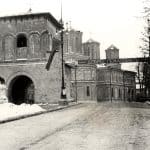Lipscani Street is almost synonymous with the historical center of Bucharest, nowadays. The street is less than 1km away and starts from the street Anghel Saligny (sector 5), ending in Calea Moşilor (sector 3).
The name derives from the word lipscan, attributed to merchants selling on the Romanian markets goods brought from Lipsca, the old name of the current city of Leipzig. The first mention of the street is in 1589, when it was known as “Uliţa Mare”. At first, the street was very narrow and made the connection between the Mogoşoaia Bridge (former Victoria Street) and the commercial center of Bucharest. Its importance increases in Constantin Brâncoveanu’s time, becoming the starting point for the commercial roads to Wallachia, the East and the West of Europe.
The area was the site of many shops, shops, workshops and inns, being an important meeting point for the merchants of the time. Also, Lipscani was the only place in Bucharest where there were no living apartments. At the beginning of the 19th century, here is built perhaps the most famous Han of Bucharest, the Inn with Tei, which exists today, having been inscribed above the entrance, in stone, the year when it was built, 1833.



